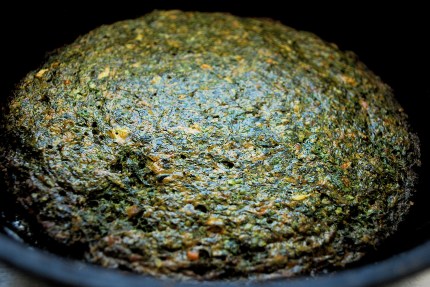The Persian New Year, called Norooz, occurs at the spring equinox, which falls on March 20 this year. Norooz is an ancient Zoroastrian holiday celebrated by Iranians around the world, regardless of religion. It’s a time for renewal and setting good intentions for the year to come.

Several specific foods are displayed or eaten at Norooz, of which one of the most important is fresh green herbs, or sabzi in the Persian language Farsi. For the holiday, pretty green wheat grass is grown in jars, and feasting families eat rice cooked with herbs sabzi polow, and a simple dish of eggs baked with fresh herbs and mild spices known as kuku.

Kuku caught my eye this year when I was putting together the menu for my Persian cooking class in Austin, TX. It’s simple, healthy, and seasonal, as well as fun to say; I can’t seem to pronounce the word “kuku,” which sounds like “cuckoo,” without giggling.
The dish is easy to make, but has a subtle and complex flavor from aromatic herbs like cumin and fenugreek, and savory, smokey hints from dried rose petals and ground walnuts. You can find edible rose petals at Middle Eastern stores, or make them yourself by drying organic rose petals on a screen in a warm, dry place.
The kuku can be eaten hot out of the oven, or at room temperature. I recommend serving it sliced as part of a Persian-style antipasto spread along with yogurt, a flatbread such as pita, sliced radishes, toasted pistachios, pickles, feta cheese, cooked lentils, and sliced hard-boiled eggs. Have a small decanter of extra virgin olive oil nearby, along with several wedges of lemon.
Recipe: Kuku Sabzi
I have many beautiful Persian cookbooks at home, most of which are by Najmieh Batmanglij, an Iranian author who lives in Washington, DC and who has written extensively about Persian cuisine. This recipe is adapted from the recipe for Fresh Herb Kuku in her book Persian Cooking for a Healthy Kitchen. It’s important that the fresh herbs be dried thoroughly after washing or the water will make the texture of the kuku spongy.
Serves 6
7 eggs
¼ cup finely ground walnuts
2 teaspoons dried rose petals, crushed
1 teaspoon baking powder
½ teaspoon cinnamon
¼ teaspoon cardamom
1 teaspoon ground cumin
1 tablespoon dried fenugreek
1/8 teaspoon turmeric
1 teaspoon freshly ground black pepper
1 tablespoon flour
3 tablespoons olive oil
2 cloves garlic, crushed
1 bunch parsley coarsely chopped
1 bunch scallions coarsely chopped
1 bunch coriander leaves coarsely chopped
1 bunch fresh dill coarsely chopped
Salt
Preheat oven to 350 ºF.
Crack eggs into a large bowl. Add walnuts, rose petals, baking powder, cinnamon, cardamom, cumin, fenugreek, turmeric, salt, pepper, flour, and one tablespoon olive oil. Whisk lightly.
Place garlic, parsley, scallions, coriander, and dill in the bowl of a food processor. Pulse 15-20 times until the herbs are finely chopped. Fold herbs into the eggs.
Place an 8-inch round ovenproof pan or baking dish in the oven and heat for 5 minutes. Pour in the remaining 2 tablespoons of olive oil, followed by the egg mixture. Season lightly with salt. Bake for 30 minutes, then rotate the dish and continue baking for another 30 minutes.
Unmold the kuku by loosening the edge with a knife and inverting onto a serving platter. Slice and serve hot or cold with flat bread and yogurt.






What a PERFECT idea for a spring dinner party!!! Please be advised I am stealing it toute suite!
this kuku looks great! what a lovely blog! best wishes,
Azita
this kuku looks great! what a lovely blog! best wishes,
Azita
Hi there, we just had a look at the “food of life” book from Najmieh Batmanglij in a shop this weekend – first time I saw it physically (= outside our Amazon wish list!!). It is indeed an impressive tome & selection with so much variety! But it looks pretty complex and advanced (although so much information). Do you have recommendations for any other book on persian cooking that might be more digestible for novices (other than yours, which we just received a few days back ;)?
Hey, thanks for picking up my book! I’ve always been a fan of The Legendary Cuisine of Persia, by Margaret Shaida. Also, Persian Cuisine: Traditional, Regional, and Modern Foods, by M.R. Ghanoonparvar. This second book has a photo for nearly every recipe. Have you checked out Pomegranates and Roses: My Persian Family Recipes, by Ariana Bundy? It has gotten really good reviews.